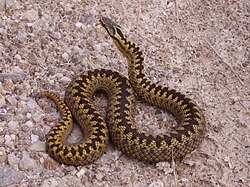Adder
| Adder | |
|---|---|

| |
| Scientific classification | |
| Kingdom: | |
| Phylum: | |
| Subphylum: | |
| Class: | |
| Order: | |
| Suborder: | |
| Family: | |
| Subfamily: | |
| Genus: | |
| Binomial name | |
| Vipera berus (Linnaeus, 1758)
| |

The adder, Vipera berus is a venomous viper that can be found throughout most of Western Europe and all the way to East Asia. It is the only venomous snake in the British Isles.[2]
They are not highly dangerous: the snake is not aggressive and usually only bites when alarmed or disturbed. Bites can be very painful, but they are rarely fatal. The snake is not threatened, though it is protected in some countries.
Description
[change | change source]Adults grow to about 60 centimeters (24 in) in length. The largest, at around 90–104 (35–41 in), are found in Scandinavia. In France and Great Britain, the maximum size is 80–87 centimeters (31–34 in), weighing from 50 grams (1.8 oz) to about 180 grams (6.3 oz).
Unusually for snakes, the sexes can be seen by their colour. Females are usually brownish with dark-brown markings, the males are pure grey with black markings.
The species has two morphs. The common pattern is the one with dark stripe with crossbars along the back, on a lighter body. The melanistic morph is very dark all over. The dark morph is more common in females. Polymorphism is usually maintained by natural selection.[3][4]
The adder has a wide range. It lives in across Eurasian.In several European countries it is the only native venomous snake.
The adder's diet is mainly small mammals such as mice, voles, shrews and even weasels and moles. Sometimes, they eat slow worms and lizards. They feed on amphibia, such as frogs, newts, and salamanders. There have been reports of adders eating birds, especially nestlings and eggs. Adders are ovoviviparous. Once they reach about 30 cm (1 ft) in length, their diet becomes adult.
They are protected by law in the U.K., (Wildlife and Countryside Act 1981), and by the Berne Convention (the Berne Convention on the Conservation of European Wildlife and Natural Habitats). It is a crime to harm them.
References
[change | change source]- ↑ http://www.iucnredlist.org/apps/redlist/details/157248/1
- ↑ Appleby L.G. 1971. British snakes. London: Baker. ISBN 0-212-98393-8
- ↑ Ford E.B. 1965. Genetic polymorphism. All Souls Studies, Faber & Faber, London.
- ↑ Ford E.B. 1975. Ecological genetics. 4th ed, Chapman and Hall, London.

